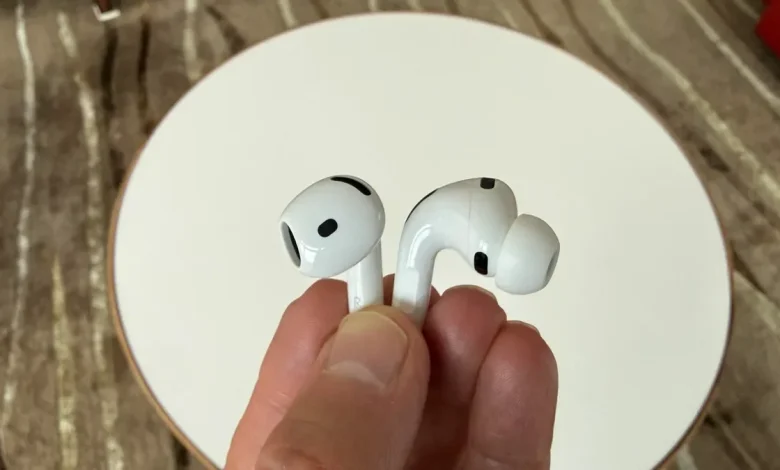AirPods Pro 3 vs. AirPods 4: Which Apple Earbuds Should You Get for Black Friday?

A friend of mine recently asked me what the best AirPods were, and I told him the AirPods Pro 3. I said they had the best sound quality and noise canceling. When I spoke to him a few days later, I was surprised to hear that he’d bought the AirPods 4 with Active Noise Cancellation. In fact, he’d bought one pair for himself and another for his son. I asked him why.
It mostly came down to price, he said. The AirPods 4 with ANC are available at a deeper discount, currently listed on Amazon for $100, which is $79 less than their original list price of $179. While the AirPods Pro 3 have also been available at discounted prices, dropping to as low as $200 ahead of Black Friday, that’s still $100 more than what the AirPods 4 with ANC cost. He wasn’t willing to pay that much and didn’t mind that the AirPods 4 have an open design. In fact, he liked that they did. “I basically got two pairs of AirPods for the price of one,” he said.
I understood where he was coming from, so I didn’t make him second-guess his decision. But I thought it’d be a good idea to offer some detailed comparisons of the 2025 AirPods Pro 3 versus the 2024 AirPods 4 (including that earlier model’s entry-level standard version (currently $80), which leaves off noise-canceling and wireless charging. That way, you can make the right decision if you’re considering buying any of them when they get marked down for Black Friday and Cyber Monday.
Read more: Are the AirPods Pro 3 Steve Jobs’ Ultimate Audio Legacy?
Like
- Design upgrades to the buds and ear tips improve their fit
- Noise cancellation has been upgraded and is now top-notch
- They sound better with improved bass response and more clarity
- Built-in heart-rate monitoring with new sensors
- Excellent voice-calling performance (upgraded microphones)
- Battery life rated for up to 8 hours (up from 6 for AirPods Pro 2)
Don’t like
- They still use the H2 chip found in the AirPods Pro 2
- Heart-rate monitoring is buried in fitness apps
- While they work with Android, many of their features are exclusive to Apple devices
- Some new colors would be nice
Why I like them
While I didn’t get a new H3 chip and I was hoping that the charging case would be able to convert into a Bluetooth transceiver to use the buds on a plane with an in-flight entertainment system, I did get most of what I was looking for in the AirPods Pro 3. The changes may seem incremental to some folks, but all the key elements, such as fit, sound quality and noise cancellation, have been noticeably leveled up along with single-charge battery. They’re about as close as earbuds get to being complete: excellent noise cancellation, strong voice-calling performance and sound quality that rivals the very best. Few buds excel in all three areas — and the Pro 3s manage it while packing in plenty of extra features, including their new heart-rate monitoring feature. Read my full review.
Reasons to buy
As I said, these buds are significantly improved in the four most important areas: fit, sound quality, noise cancellation and battery life. The result is that you don’t feel like you’re making any compromises when buying the AirPods Pro 3 if you’re an Apple user.
Reasons to skip/keep looking
While they work with Android devices, you lose many of the AriPods 3’s extra features if you’re not using them with Apple devices (iPhones and iPad in particular). They also may just be a little too expensive for many folks.
Read our Apple AirPods Pro 3 review.
Like
- Lightweight, more compact design and comfortable fit (should fit more ears securely than Airpods 3)
- First open earbuds with effective Active noise canceling (ANC)
- Improved sound quality with new acoustic architecture
- Equipped with Apple’s powerful H2 chip that enables a robust feature set and faster digital processing
- Compact case has wireless charging and speaker for Find My (missing from entry-level model, however)
Don’t like
- Even with slightly smaller design, the buds may not be a good fit for some ears
- Battery life could be a little better
- Noise-canceling is only about half as good as the AirPods Pro’s ANC
Why I like them
The AirPods 4 are, unsurprisingly, the fourth generation of Apple’s original true-wireless earbuds, which feature an open design. This means they don’t have silicone ear tips, unlike the AirPods Pro 3. Not only do they feature a slightly smaller design and better sound than their predecessor, but they’re equipped with Apple’s H2 chip that improves overall performance and powers Apple’s ever-expanding AirPods features, though they don’t have the AirPods Pro 2’s Hearing Aid mode. Read my Apple AirPods 4 review.
The AirPods 4 come in two versions: a $129 entry-level model and a $179 step-up model with active noise canceling. ANC is a rare feature for open earbuds because it typically doesn’t work with an open design, but these are the first open buds I’ve tried to have active noise canceling that actually works (it’s about half as strong as the AirPods Pro 2’s noise canceling and 25% as strong as the AirPods Pro’s 3). That’s pretty cool and worth the extra $50 if you can afford it.
Reasons to buy
A lot of people don’t like having ear tips jammed in their ears and find open earbuds more comfortable (plus, you can hear the outside world for safety reasons), and the AirPods 4 are made for those Apple users. They also sound very good for open earbuds and feature excellent voice-calling performance along with Apple’s spatial audio and likable pinch controls. The AirPods 4 with Active Noise Canceling are more special simply because they feature noise canceling. No, the AirPods 4 with ANC’s noise muffling capabilities aren’t as great as those of the AirPods Pro 3 and top noise-canceling earbuds like the Bose QuietComfort Ultra Earbuds (2nd Gen) or the Sony WF-1000XM5. But that it works at all and is reasonably effective is kind of wild because, as I said, noise canceling and open earbuds usually aren’t a good mix.
Reasons to skip/keep looking
While their slightly smaller, updated design fits a wider range of ears more securely, some folks may not get a secure fit. The AirPods Pro 3 offer a more flexible fit because they include five different sizes of ear tips. They also deliver better sound with more bass in a noise-isolating design (the AirPods Pro 3’s excellent noise canceling is significantly better than that of the AirPods 4 with ANC).
Read our AirPods 4 with ANC review.
AirPods Pro 3 vs. AirPods 4: What’s similar
- The AirPods Pro 3 and both AirPods 4 models (with and without ANC) are powered by Apple’s H2 chip.
- The AirPods Pro 3 and AirPods 4 models are equipped with Bluetooth 5.3, just like the AirPods Pro 2 (though some true-wireless earbuds have already jumped to Bluetooth 6.0).
- The AirPods Pro 3 and AirPods 4 with ANC both have a MagSafe charging case with USB-C and wireless charging. Note that the entry-level AirPods 4 do not support wireless charging. None of the three models come with a USB-C charging cable.
- The AirPods Pro 3 and both versions of the AirPods 4 (with and without ANC) support Apple’s new Live Translation feature. They also all feature Apple Personalized spatial audio with head-tracking.
- The AirPods Pro 3 and both versions of the AirPods 4 (with and without ANC) have always-on Siri and automatic switching between Apple devices on your iCloud account.
- The AirPods Pro 3 and AirPods 4 with ANC share very similar sets of features, even beyond active noise canceling. Adaptive Audio, which adjusts the level of noise canceling on the fly, and Conversation Awareness mode, which lowers the volume of your music and engages transparency mode, are available on both the AirPods Pro 3 and AirPods 4 with ANC. Note that the entry-level AirPods 4 don’t include those features because they lack noise canceling and a transparency mode.
AirPods Pro 3 vs. AirPods 4: What’s different
- While they look similar from the outside, the AirPods Pro 3 and AirPods 4 fit differently. The AirPods Pro 3 feature a foam-infused noise-isolating design with silicon eartips in five sizes — extra-extra small, extra small, small, medium and large. The silicon eartips are designed to seal off your ear canal, while the AirPods 4 have an open design with no eartips.
- The AirPods Pro 3 weigh more per bud (5.55 grams) compared to the AirPods 4 (4.3 grams).
- The AirPods Pro 4 with ANC’s case is smaller and lighter than the AirPods Pro 3’s case (34.7 grams vs. 43.99 grams).
- The AirPods Pro 3 have 3 microphones per earbud, while the AirPods 4 have two per bud. However, both offer very good voice-calling performance.
- The AirPods Pro 3 are equipped with heart-rate sensors, similar to those found in the Beats Powerbeats Pro 2. The AirPods 4 do not have heart-rate sensors.
- The AirPods Pro 3 have significantly better noise cancellation than the AirPods 4 with ANC (up to 4x better, according to Apple).
- The AirPods Pro 3 support Apple’s Hearing Aid feature, while the AirPods 4 don’t.
- While both models are dust-resistant, the AirPods Pro 3 and their charging case have an IP57 rating, which means they can be submerged in water up to 1 meter deep for 30 minutes. The AirPods 4 are IP54 splash-proof.
- The AirPods Pro 3’s battery life is better (up to 8 hours with noise-canceling on, compared to up to 5 hours for the AirPods 4 with ANC).
- The AirPods Pro 3’s case features a U2 chip, which boosts the Precision Finding range in the Find My app by 1.5x (requires an iPhone 17). The AirPods 4 with ANC’s case is equipped with the U1 chip, which supports Precision Finding. In contrast, the standard AirPods 4’s case lacks the U1 chip and supports a less advanced version of Find My.
- The cases for both the AirPods Pro 3 and AirPods 4 no longer have a button for Bluetooth pairing. You simply double-tap on the front of the case to put the buds into Bluetooth pairing mode.
- You can see a full feature comparison of the AirPods Pro 3 and AirPods 4 with ANC here.
Watch this: Apple AirPods Pro 3 Review: The Complete Package
11:18
AirPods Pro 3 and AirPods 4 fit differently
While the AirPods Pro 3 and AirPods 4 look similar at first glance, they do feel different in your ears. Some people simply don’t like having eartips jammed in their ears and prefer the open design of the AirPods 4, which allows them to nestle in more comfortably. However, more people seem to have issues getting a secure fit with Apple’s standard AirPods compared to the Pro models.
The original AirPods and AirPods 2 had a smaller design that fit certain ears very well, though they weren’t a great match for my ears (they would slip out a little too easily). Apple moved to a slightly bigger bud for the AirPods 3, improving their sound, but the new design didn’t quite work as well as for some AirPods 2 users.
Read more: Best Wireless Earbuds of 2025
A closer look at the buds side by side.
The AirPods 4 are slightly smaller than the AirPods 3 and have a slightly different shape. They fit my ears pretty well, but I still get a more secure fit from the AirPods Pro 3, with redesigned eartips that seem to offer a snugger, more secure fit for more people (the good thing about eartips is they come in different sizes, so if one doesn’t get you a tight seal, you can try another).
Ultimately, if you prefer the way the AirPods 4 fit your ears compared to the AirPods Pro 3, it makes your decision easier. The same is true if the AirPods Pro 3 fit better. Things get more complicated if you like the way both fit. Then you’ll have to weigh the importance of sound quality and noise-canceling performance.
AirPods 4 open earbuds have very good sound, but AirPods Pro 3 are significantly better
The sound quality of open earbuds has improved substantially over the last several years, and the leap in sound quality from the original AirPods and AirPods 2 to the AirPods 4 is quite significant. Apple has managed to really step up the bass performance, which often suffers with an open design, and the AirPods 4 offer quite respectable sound (and that sound has a nice openness to it, given that these are open earbuds, after all).
The AirPods Pro 3’s case (left) is larger than the AirPods 4’s case (right).
However, thanks to their noise-isolating design, the AirPods Pro 3 sound fuller and more dynamic, with more powerful bass. Also, because the AirPods 4’s open design allows ambient sound to leak into your ears, if you’re listening to them in noisy environments, the sound quality is impacted, particularly for the entry-level AirPods 4, which have no ANC. It’s also worth noting that while Apple has done a remarkable job creating open earbuds with effective noise canceling, it’s not entirely effective and can only muffle so much ambient noise.
Noise-canceling comparison: AirPods Pro 3 vs. AirPods 4 with ANC
Apple says the AirPods 4 with ANC offer similar noise canceling to the original AirPods Pro. According to Apple, the AirPods Pro 2 offer twice the noise canceling of the original AirPods Pro, and the AirPods Pro 3 provide twice the noise canceling of the AirPods Pro 2. That would mean the AirPods Pro 3 have 4x better noise-canceling performance than the AirPods 4 with ANC.
I should note that some of that superior noise-canceling performance is related to the passive noise isolation you get from the AirPods Pro 3’s eartips sealing off your ear canal. Any way you look at it, the AirPods Pro 3 have some of the best noise cancellation available right now. In my review, I pitted them against Bose’s $299 QuietComfort Earbuds (2nd gen), which were released a few weeks before the AirPods Pro 3 in the US. Many reviewers said they had the best noise cancelling, and I felt that way, too, until I tried the AirPods Pro 3. Then, I wasn’t so sure.
Enlarge Image
Testing the AirPods Pro 3 in the streets of New York.
I didn’t feel I could declare one better than the other without running my own lab tests on a rather expensive rig that CNET doesn’t own, but I was quite impressed with the AirPods Pro 3. Compared to the noise-canceling capacity on the AirPods Pro 2, I could definitely hear the difference when I used the buds on a plane, in the noisy streets of New York and underground in the subway.
Read more: AirPods Pro 3 vs. AirPods Pro 2 — should you upgrade?
Do you really need the AirPods Pro 3’s heart-rate monitoring?
I personally don’t feel that heart-rate monitoring is a must-have feature, particularly if you already own a smartwatch with the feature. But for some folks, it will be a welcome addition.
The heart-rate sensors have been custom-designed for the AirPods Pro 3 (Apple’s smallest heart-rate sensors) and aren’t identical to the ones in the Powerbeats Pro 2. But the experience using the heart-rate monitoring feature remains the same.
There may be more to come, as Apple has a habit of leaving off a few tricks when it first launches products (remember that the AirPods Pro 2 didn’t have spatial audio when they launched). I tend to think we’re not done hearing about the heart-rate sensor and future health applications for the buds.
Enlarge Image
The AirPods Pro 3 have heart-rate sensors like the Powerbeats Pro 2, but they’re custom-designed for the AirPods Pro 3.
How about voice-calling performance?
One could argue that the AirPods Pro 3 have slightly better voice-calling performance, but the truth is, both the AirPods 4 and AirPods Pro 3 offer excellent voice-calling performance with good background noise reduction while picking up your voice clearly. That said, in noisy environments, the superior noise canceling of the AirPods Pro 3 does help, allowing you to hear callers more clearly.
Should I get the AirPods 4 or AirPods 4 with ANC?
If you’re looking to spend as little money as possible for a set of AirPods, the entry-level AirPods 4 are selling for all-time low prices this holiday buying season and are very good open earbuds for Apple users with support for automatic switching between Apple devices and features like spatial audio with head-tracking and Live Translation. However, I try to steer folks toward the AirPods 4 with ANC because they’re clearly more special and don’t cost significantly more than the standard AirPods 4.
Can’t decide between the AirPods 4 and AirPods Pro 3?
If you can’t decide, you can wait for the next-generation AirPods to be released. Reports suggest that Apple is working on both the AirPods 5, which feature an open design, and the next-gen AirPods Pro, with rumors suggesting they may get infrared cameras for gesture controls and an upgraded H3 chip.
Based on past AirPods product cycles, the AirPods Pro 4 should be two years away (2027) while the standard AirPods (the AirPods 5) should be slated to come out next year. But word has it that the next AirPods Pro, whatever they’re called, may arrive as soon as next year (2026) and may be an even more impressive upgrade than what we got moving from the AirPods Pro 2 to the AirPods Pro 3.
Disappointingly, I’m hearing that the AirPods Max over-ear headphones won’t get an upgrade next year, and we may not get a true next-gen version of the AirPods Max for a few years. Released in 2020, the pricey AirPods Max are only equipped with Apple’s H1 chip and are really due for an upgrade. But Apple seems more focused on the development of its AirPods earbuds rather than its full-size headphones.
Read more: Apple Reportedly May Add Infrared Cameras to Its Next AirPods Pro
AirPods Pro 2 vs. AirPods Pro 3 vs. AirPods 4 with ANC spec comparison
Weight (each earbud)0.19 ounce (5.13 grams)0.20 ounce (5.5 grams)0.15 ounce (4.3 grams)Weight (case)1.79 ounces (50.8 grams)1.55 ounces (43.99 grams)1.22 ounces (34.7 grams)Water resistantIPX4IP57IP54SensorsSkin-detect sensor, Optical in-ear sensor, Motion-detecting accelerometer,
Speech-detecting accelerometer, Force sensorSkin-detect sensor, Optical in-ear sensor, Motion-detecting accelerometer,
Speech-detecting accelerometer, Force sensor, heart-rate sensorOptical in-ear sensor, Motion-detecting accelerometer,
Speech-detecting accelerometer, Force sensorMicrophonesDual beamforming microphones, inward-facing microphoneDual beamforming microphones, inward-facing microphoneDual beamforming microphones, inward-facing microphoneChipH2H2H2ConectivityBluetooth 5.3Bluetooth 5.3Bluetooth 5.3Active Noise cancellation,
transparency modeYesYesYesConversation awareness,
adaptive audioYesYesYesVoice isolation,
personalized volumeYesYesYesBattery lifeUp to 6 hours
+30 hours with caseUp to 8 hours
+24 hours with caseUp to 5 hours
+30 hours with caseWire in boxYesNoNoLaunch price in US$249$249$179




